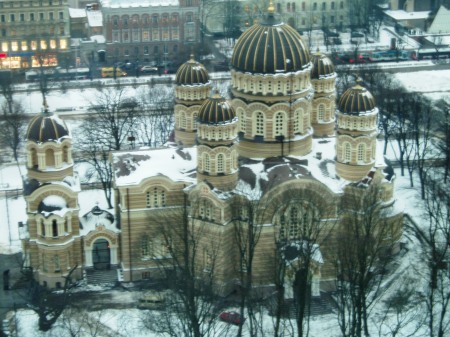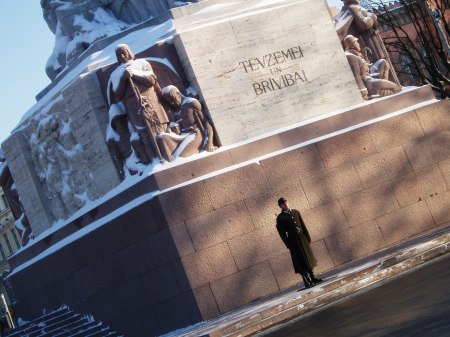When I woke I could hear the sound of the old lady snow clearer scratching away at the pavement below and I thought this sounded promising so I rushed to the lobby where I knew Micky would be waiting following his early morning walk.
He assured me that there had been some snow but unfortunately it had recently turned to rain and this had washed away the two or three inches that had fallen earlier that morning. Was he teasing? I couldn’t tell but a step outside confirmed that the old lady was simply scraping away the dirty brown slush that remained in the taxi rank. I certainly would not have predicted this but the temperature had continued to rise and the snow that only two days ago looked a permanent feature had almost completely gone.
After breakfast Kim cleaned her boots and emptied the shoeshine machine of all of its wax and polish for at least the third time and we walked again through the art nouveau district then through the parks to the city centre. This time we had to negotiate sprawling puddles of melted snow and the whole place was suddenly less attractive. The Orthodox Cathedral was less impressive under a grey sky, the statue at the top of the Freedom Monument looked unhappy and the guards at the base were miserable. The canal was no longer frozen but at least the ducks had somewhere to swim again. Now and again some bits of blue sky skidded past but there was never enough to replace the leaden grey skies.
So we needed to find some things to do inside. First we went to the little café at the House of the Blackheads and then we went inside to the see the museum. This building was completely destroyed in 1945 and there were photographs inside to prove it. In fact most of the Town Hall Square outside had been reduced to rubble but had all now been replaced. The restoration was truly impressive and the building had been completely rebuilt in its original style. Inside there were exhibits that had miraculously escaped the pillage that had accompanied the various occupations.
After the museum we went for lunch and because of the weather we prolonged this stay longer than we normally would. Micky gave an informative talk on sheep shagging and Christine contributed to this with an impressive repertoire of lamb impressions. We had some rambling and reminiscing conversations ranging from ‘what we used to do in the snow’ to the boring things we did as kids including such glorious pastimes as I Spy books and car number plate spotting.
After only a single glass of wine Calamity Christine got up off of the bench and whilst getting her leg-over got tangled up in Micky’s sleeve which resulted in a dramatic headlong crash to the floor. As if this wasn’t funny enough she spun round, sat up with an accusing glare and shouted “MICKY!” which drew the attention of everyone around. And he hadn’t even touched her! Luckily she was unhurt and we were joined in our amusement by all of the other customers in the place.
It was still gloomy and we needed more indoor activity so we walked out of the centre towards the shops and on the way we passed through some streets that were yet to benefit from the city regeneration project. Here there remained the legacy of the communist era, some original buildings bearing the scars of abandonment and neglect waiting their turn for refurbishment and other ugly functional concrete buildings added during the occupation period. The Russians especially liked concrete and had added acres of hideous grey cement to the city, overwhelmingly dreary and the most unsightly blots on the environment and hopefully now all waiting their turn for demolition.
There was no chance of improvement in the weather so we made our way back to the Skyline bar for what had become our late afternoon refreshment break. The lounge lizard was there again and there were more Brit-louts behaving badly in one corner but we didn’t let this spoil it for us. Because of the weather we stayed there for the rest of the afternoon and had some tasty and reasonably priced plates of food and a final drink or two and enjoyed some last views of Riga.
Back now to that brilliant idea to book and pay for the transport to the airport in advance. A taxi arrived at the agreed time we piled in and set off to the airport. It was observant Kim who first noticed that this was not the same driver that we had made the arrangement with so whether he treated himself to a bottle of Balsam and stayed at home tonight or turned up at the Albert and wrote us off as generous time wasters we will never know. Micky did his best to explain that we had paid in advance but the driver was not responsive so he had to be paid as well!
At the airport Kim played Miss Marple when she spotted some doubtful looking characters checking in with empty bags that thirty minutes later were suspiciously bulging and a quick examination of the rubbish bin into which they had discarded some litter confirmed that they were cigarette smugglers.
We arrived home five minutes ahead of schedule and then the airport and the immigrations conspired to hold us up for forty minutes to compensate for this. I felt a complaint coming on and challenged the immigration staff for an explanation into this unacceptable treatment and an apology for the delay but naturally received neither. Finally there was a second fiasco at immigrations when the staff tried to identify passengers from the Riga flight in a search for the smuggled cigarettes. They should have asked Kim, she knew exactly where they were. It was a pantomime and a complete failure with a procedure that leaked like a damaged sieve but thankfully it was only cigarettes they were looking for and nothing more sinister.
It had been a good four days and on the way home I reflected on the highlights which for me were the snow, the art nouveau area, the beach at Jurmala, the Spa, the Skyline bar and the amusing taxi Russian taxi driver.
_________________________________________________
More posts about Riga…
Rosa Klebb’s endurance sightseeing tour of Riga
Latvia Dining – a Chronic Case of Indecision
Riga – Festival of the Family and a BBQ
_______________________________________________












